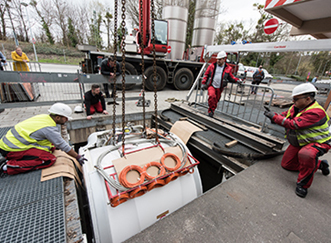Faster and more precise: new high-performance MRI in Freiburg

With the new MRI device, it will be possible to examine people who previously could not use the scanner because of their health status. Technology analyzes patients' breathing patterns and corrects motion blur.
For many examinations carried out with magnetic resonance imaging (MRI), it is necessary to hold your breath. However, some patients cannot do this because of their state of health, resulting in blurry images which make diagnosis more difficult. Since mid-March, the Department of Radiology at the Medical Center – University of Freiburg has been one of the first clinics in the world to correct for respiratory motion using the new high-performance "Magnetom Vida" MRI scanner from Siemens. Its performance level is considerably higher than that of conventional devices, enabling much faster and more detailed images than before. As a result, this imaging method is now open to patient groups for whom an MRI examination has previously been out of the question, for example because of cardiac arrhythmia, being severely overweight, or because their health status has not allowed active support of the examination procedure by holding their breath.
"The new MRI device analyzes patients' respiratory processes, calculates movements caused by breathing during the recording, then subtracts them from the image," says Prof. Dr. Mathias Langer, Medical Director of the Department of Radiology at the Medical Center – University of Freiburg. "This also now makes it possible to examine patients who can only hold their breath very briefly." Even in these cases, the new MRI scanner delivers consistently clear images. Tumors or metastases can thus be better detected. Another big advantage of the new technology is the shorter recording time. This is an enormous relief to children or the elderly, because they do not have to lie so long in the MRI device. "For these patients the MRI examination is now much more comfortable," says Prof. Langer.
Background: Magnetic resonance imaging
Magnetic resonance imaging (MRI) is a cross-sectional imaging technique that allows soft tissue structures inside the body to be displayed very well and without harmful radiation. In an artificial magnetic field, a portion of the hydrogen atoms in the body tissue are aligned and excited by radiofrequency waves, whereupon they return to their original state. Depending on the structure and water content of the tissue, different signals are emitted, on the basis of which the sectional image is calculated. Through ever faster recording procedures, even organs in motion can be displayed, such as a beating heart.
Back